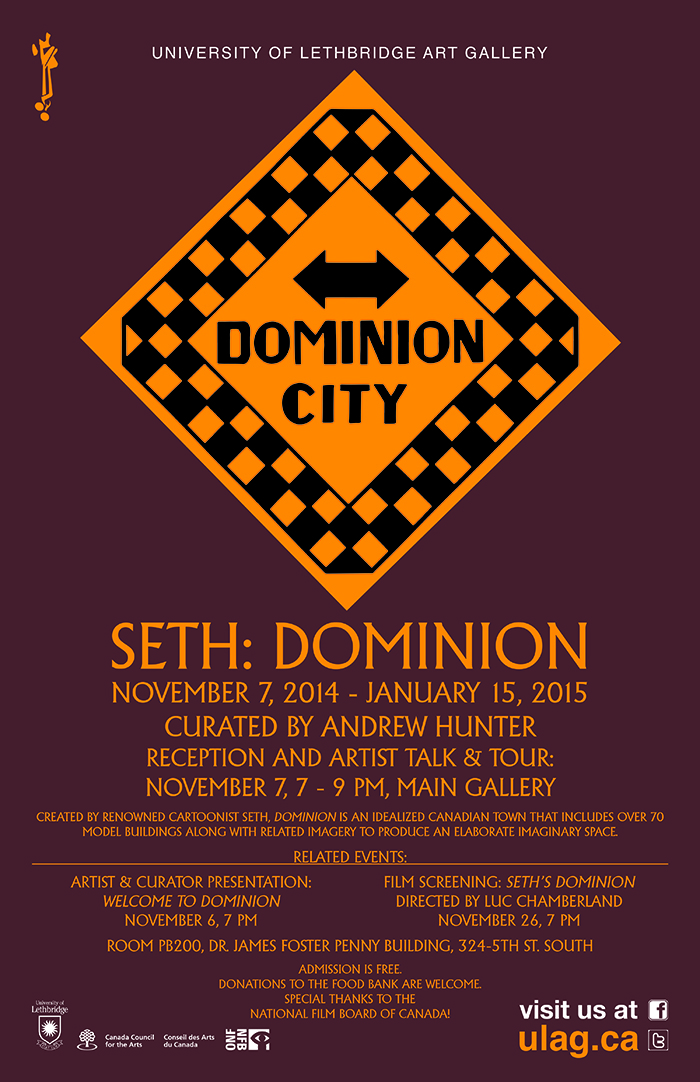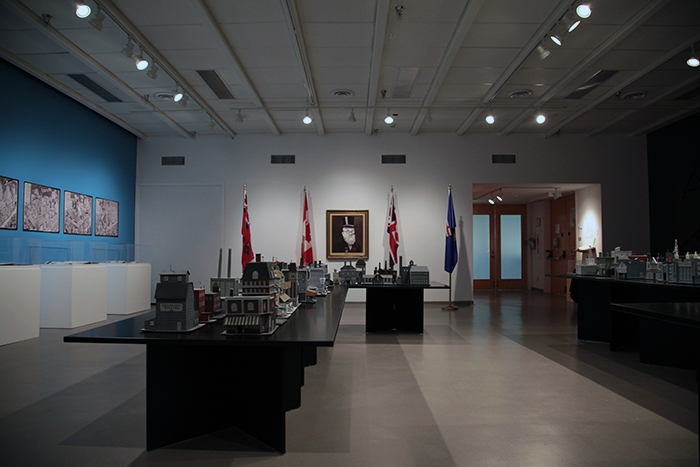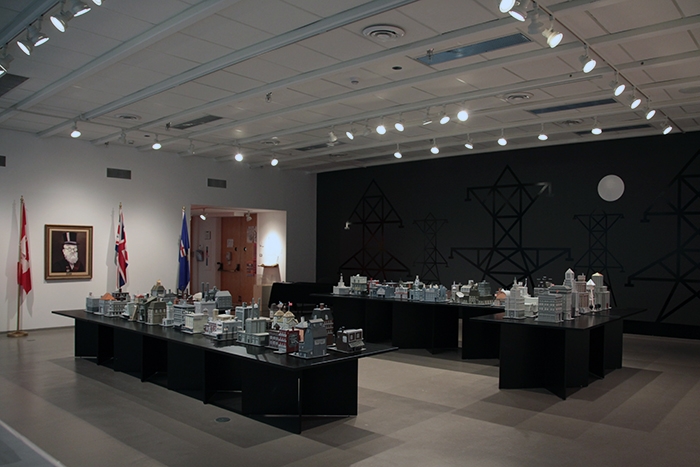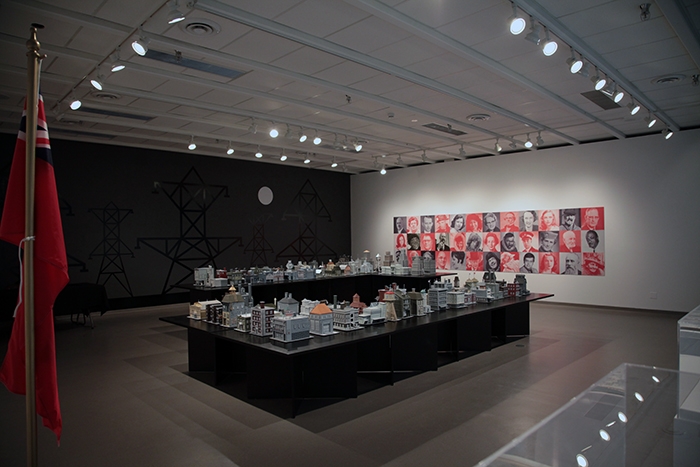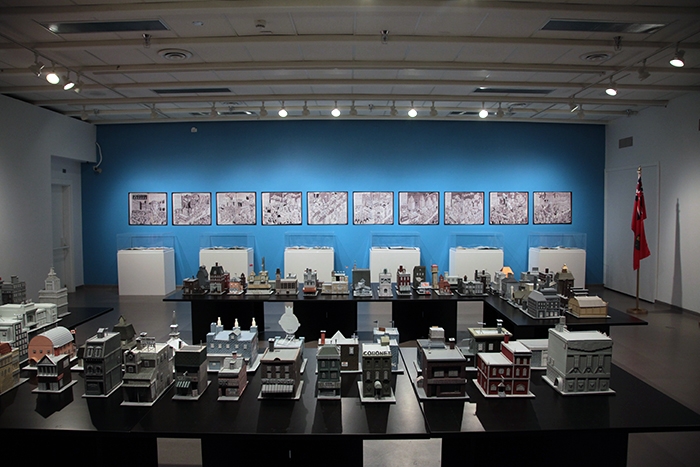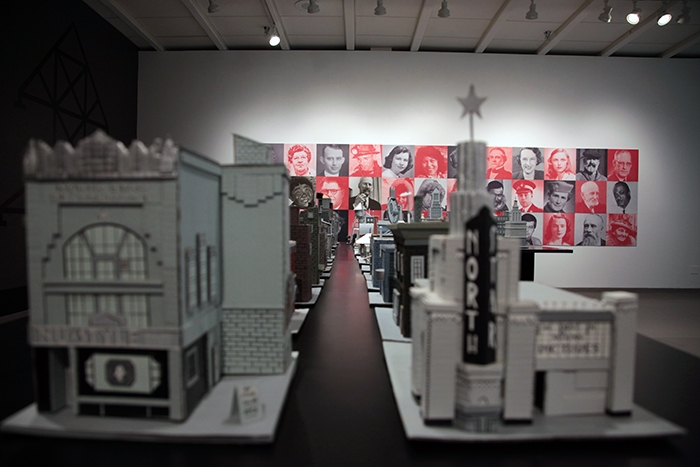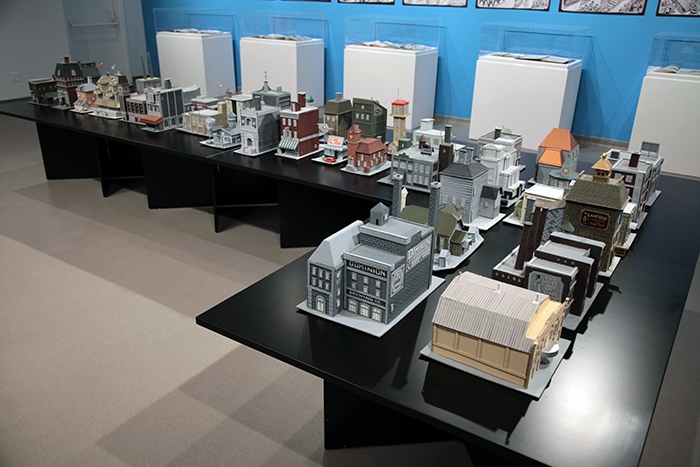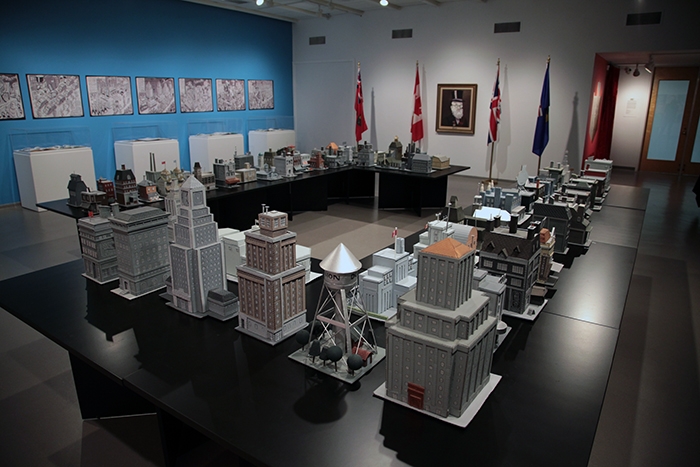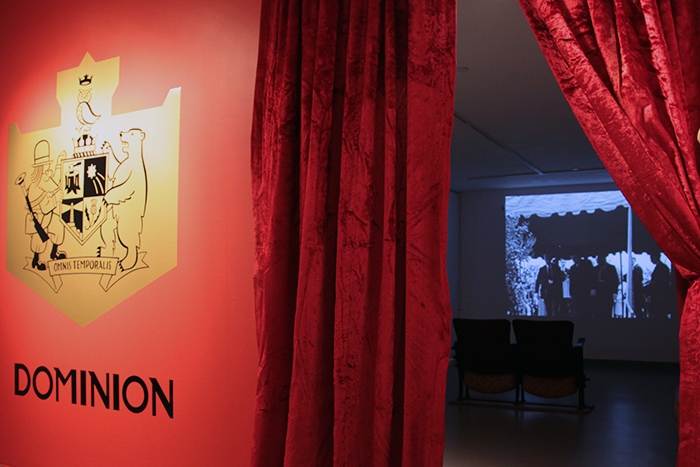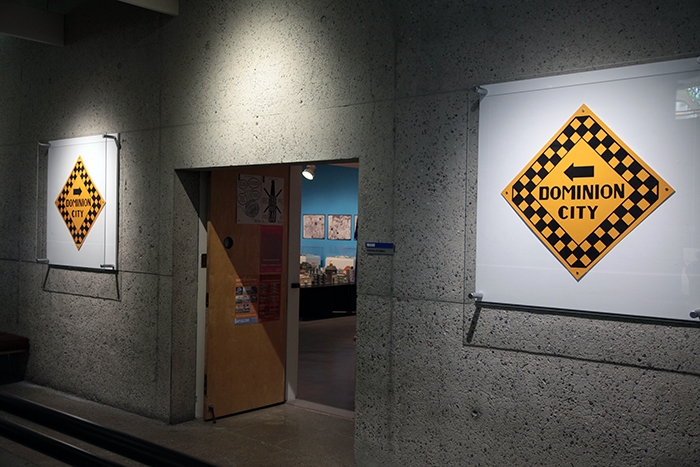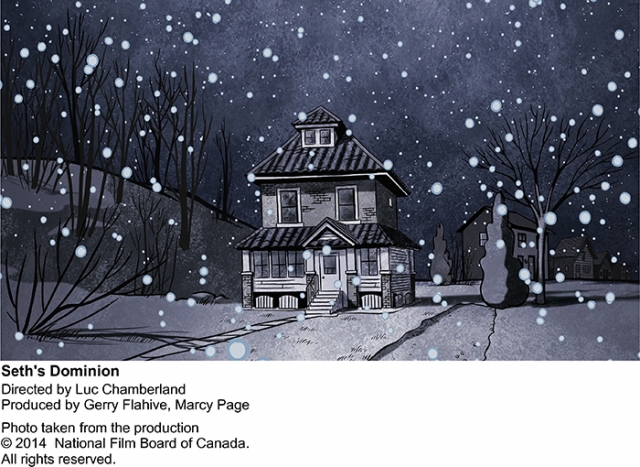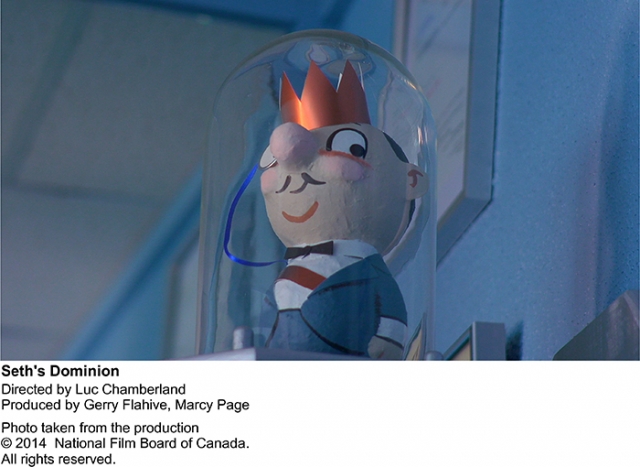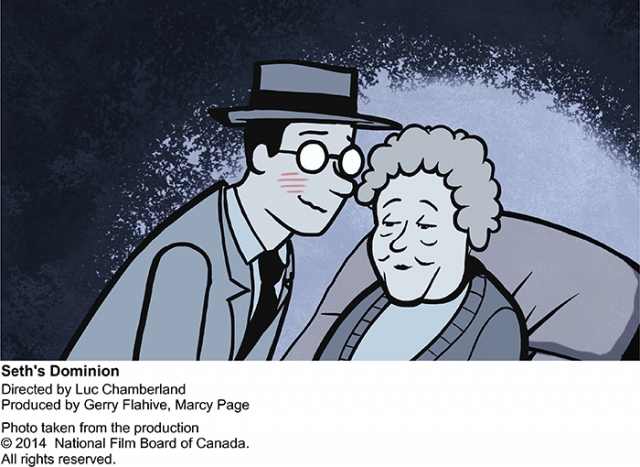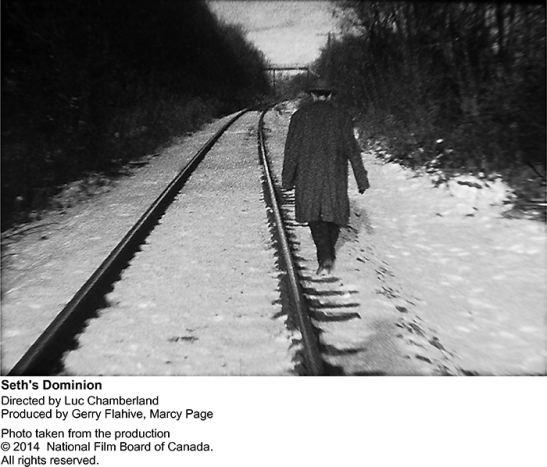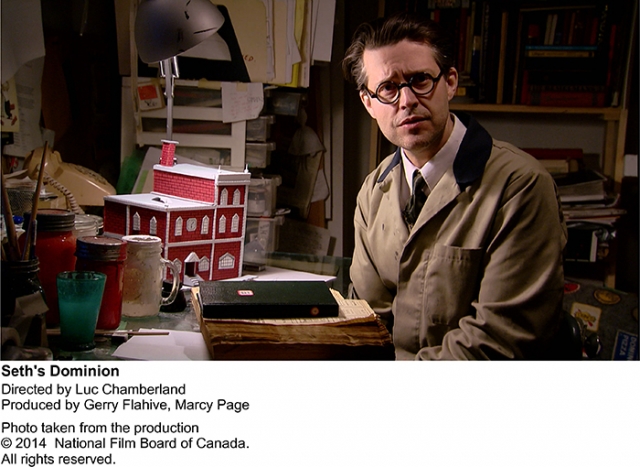Main Gallery
SETH: DOMINION
November 7, 2014 – January 15, 2015
Artist: Seth
Curator: Andrew Hunter
Hours: 10 am – 4:30 pm Daily | Open until 8:30 pm on Thursday
The Main Gallery will be open on Saturday, December 6 from 10 am to 4 pm in conjunction with Eric Dyck’s Cartooning & Comics Workshop
Created by renowned cartoonist Seth, SETH: DOMINION is an idealized Canadian town that includes over 70 model buildings along with related imagery to produce an elaborate imaginary space.
Director Statement
I am pleased to bring SETH: DOMINION to the U of L Art Gallery. Curated by Andrew Hunter, the exhibition has been presented at four galleries across Ontario and in P.E.I. to rave reviews from visitors and this is the first presentation in Western Canada. For Seth’s many avid fans, the project needs no explanation whereas for those who are not yet his fans – and I feel confident in saying those are the only two groups that can exist because to know Seth’s work is to become his fan – well, those who do not yet know DOMINION will be happy to become acquainted with this installation and with his work as a whole.
SETH:DOMINION consists of over 70 model-sized buildings that the artist has constructed from old cardboard boxes and house paint, as well as supporting material related to the people, places and events of his fictional town – the founding father, notable citizens, parades, and the town crest are featured along with sound and early National Film Board news reels to provide context. Dominion is partly an idealized mid 20th century Canadian city and partly a nostalgic imagining of a time and place that never really existed, but it is also a space where the artist’s and the visitor’s imagination can meander.
This exhibition is sure to delight a wide variety of visitor and I also hope that it will provide a starting point for thinking about the places where we live, how we imagine urban planning, and ideas of Canadian towns both past and present. In Lethbridge, we are going through a great deal of change: the city has seen waves of new immigration; there has been much expansion of suburban development with related discussion about issues like transit, bike routes, and infrastructure; and, on campus, a major new building – the largest structure on campus to date – is about to begin construction. Throughout the exhibition, the U of L Art Gallery will be working with artists to use our social media outlets and to be present in (or near) the gallery to engage visitors about the ideas which connect to this exhibition.
– Josephine Mills, Director/Curator
SETH: DOMINION
DOMINION is the elaborate, ever-expanding, work-in-progress of the renowned Canadian cartoonist Seth. An imagined place combining elements of numerous early modern Canadian cities, DOMINION captures the spirit of the booming small metropolis at a time of community boosterism and growth that, to the contemporary eye, can seem at times quaint and alien. It is a place that embodies the confidence of many Canadian cities in the post Depression and World War II era when the North American economy expanded, manufacturing spread, and many cities were characterized by a level of civic engagement, through service clubs and politics, unheard of today.
DOMINION is a cartoon space supported by an elaborate narrative vision that includes a detailed history and character studies that can be amusing, but equally dark. DOMINION sits seemingly frozen at the cusp of the 1950s and ‘60s and one can imagine many of Seth’s buildings crumbling and fading in the voracious urban “renewal” of the 1960s to the 1980s. As with all of Seth’s works, DOMINION is infused with melancholy and an air of ambiguous nostalgia tinged with a healthy dose of cynical humour.
DOMINION’s most substantial manifestation is the growing collection of model buildings constructed over the past decade that extend Seth’s distinct vision off the printed page. The Installation presented here at the University of Lethbridge Art Gallery is the first venue in Western Canada and follows distinct installations curated by Andrew Hunter for Museum London, Ontario; RENDER (University of Waterloo), Ontario; the Dundas Museum & Archives, Ontario; the Confederation Centre Art Gallery, P.E.I.; and the Niagara Artists Centre, Ontario.
SETH is the cartoonist behind the infrequent comic book series Palookaville. Currently he is serializing the story Clyde Fans between its covers. This is a task that has gone on for a decade now and will likely continue for several more years. His books include It’s a Good Life, If you Don’t Weaken; Wimbledon Green; Bannock, Beans and Black Tea and George Sprott 1894-1975. His books have been translated into 9 languages. As a book designer he has worked on a variety of projects including the Penguin reprinting of The Portable Dorothy Parker and a recent deluxe edition of Leacock’s Sunshine sketches of a little town. He is the designer of the 25 volume series The Complete Peanuts and a monograph of the Canadian master cartoonist Doug Wright.
As an illustrator he has produced commercial works for almost all of the major Canadian and American magazines. His work has appeared inside and on the cover of the New Yorker. He won the Harbourfront Festival Prize in 2011. Seth’s books are published by Drawn & Quarterly of Montreal.
SETH: DOMINION is curated by Andrew Hunter. The U of L Art Gallery is organizing a tour to further venues in Western Canada.
Artist Statement: SETH:DOMINION
I did not begin this project with the idea of constructing a model city. In fact, the first cardboard building was built on a lark. Around the turn of the millennium I had begun to flesh out some ideas for a graphic novel that had been rolling around in my head. It was to be a group of short stories linked together by their setting. Five characters, five chapters. Each chapter would comprise the story of one of the characters and all the characters lived in the fictional northern Ontario town of Dominion.
My problem was that Dominion was an empty place to me –a cipher. It was just a skeleton of a Canadian town –it had no meat on its bones. It struck me that the story would be so much richer if I knew a lot about where these people lived. In fact, it seemed a good idea if I opened the story with a hundred pages or so about the history of the town. But where do you start when dreaming up an entire city? The easiest answer seemed to be with a single building.
I opened up a ledger book and sketched out a building and began jotting down its imagined history. I assumed by constructing the history building by building, I would write my way into connections. Something I made up today would later connect to something I made up next week. If I methodically plodded my way along, place by place, a bigger picture would develop. It crossed my mind to make a little cardboard model of the first business –something to do with my hands while my mind worked. This turned out to be a good trick because in the time it took to make a model I could usually work out what that place was all about. Before I knew it, I had a handful of these little models.
Within a year the idea for the graphic novel had withered on the vine but the city of Dominion had prospered. I discovered I was much more interested in the city and its history than the original five characters. As I had hoped, the city had taken on a life of its own and, day by day, Dominion had become less an artistic project and more of an interior landscape. I found myself walking its northern Ontario streets each night as I lay down to go to sleep. Dominion turned out to be an idealized place. A quintessential Canadian place –old and faded (in decline even) but idealized in that it contained nothing that I didn’t desire to be there.
Though I had determined the size of the city to be around that of Hamilton, Ontario, I took pleasure in the idea that the project would never be ended. Even a finite city had infinite details. I could go on describing them for the rest of my life. I hope to do just that. Building the models will undoubtedly come to a conclusion (they take up a great deal of space) but the notebooks will continue, slowly tracing out the shape and texture of Dominion.
– SETH
Artist Bio:
Seth is the cartoonist behind the long running comic book series Palookaville. His books include, Wimbledon Green, George Sprott, Clyde Fans and It’s a Good Life if you Don’t Weaken. He is the designer for The Complete Peanuts, The John Stanley Library, The Portable Dorothy Parker and The Collected Doug Wright. A deluxe edition, designed and illustrated by Seth of Stephen Leacock’s Sunshine Sketches of a Little Town has just been published. He was recently awarded the 2011 Harbourfront Festival Prize.
Curator Bio:
Andrew Hunter is an accomplished curator, artist, writer and educator. He is the Fredrik S. Eaton Curator, Canadian Art, at the Art Gallery of Ontario. Hunter has held curatorial positions at the Vancouver Art Gallery, the Art Gallery of Hamilton, the Kamloops Art Gallery, the University of Waterloo, the McMichael Canadian Art Collection and Charlottetown’s Confederation Centre Art Gallery. With Lisa Hirmer, he co-founded DodoLab, an international program of community collaboration and interdisciplinary creative research. He has lectured on curatorial practice in Canada, the United States, England, China and Croatia. Hunter most recently curated the exhibition Alex Colville and oversaw the reinstallation of the Canadian galleries featuring major works by indigenous artists.
Related Event:
Film Screening: Seth’s Dominion
November 26, 2014 | 7 PM
Room PB200, Dr. James Foster Penny Building
324-5th St. South, Lethbridge, AB
Seth’s Dominion
42 minutes, National Film Board (NFB)
Produced for the NFB by Marcy Page and Gerry Flahive
Directed by Luc Chamberland
Admission is free. Donations to the Food Bank are welcome.
Special thanks to the National Film Board of Canada for making this possible.
Synopsis:
Canadian cartoonist Seth, best known for comic books such as Palookaville, is one of the world’s great storytellers in the form. In his personal projects he transforms his poignant inner life into observant and witty graphic stories. He is also incredibly prolific, producing semi-autobiographical comics and award-winning commercial work, as well as what he calls his “little hobbies.” Director Luc Chamberland sheds light on his articulate subject, mixing insightful biography with vivid animation in an artful fusion of filmmaking techniques that perfectly captures Seth’s manifold creative universe. In this deft portrait of one of our most unique artists, Seth proves to be a wry and engaging narrator of his life story and artistic process.
National Film Board of Canada Website
